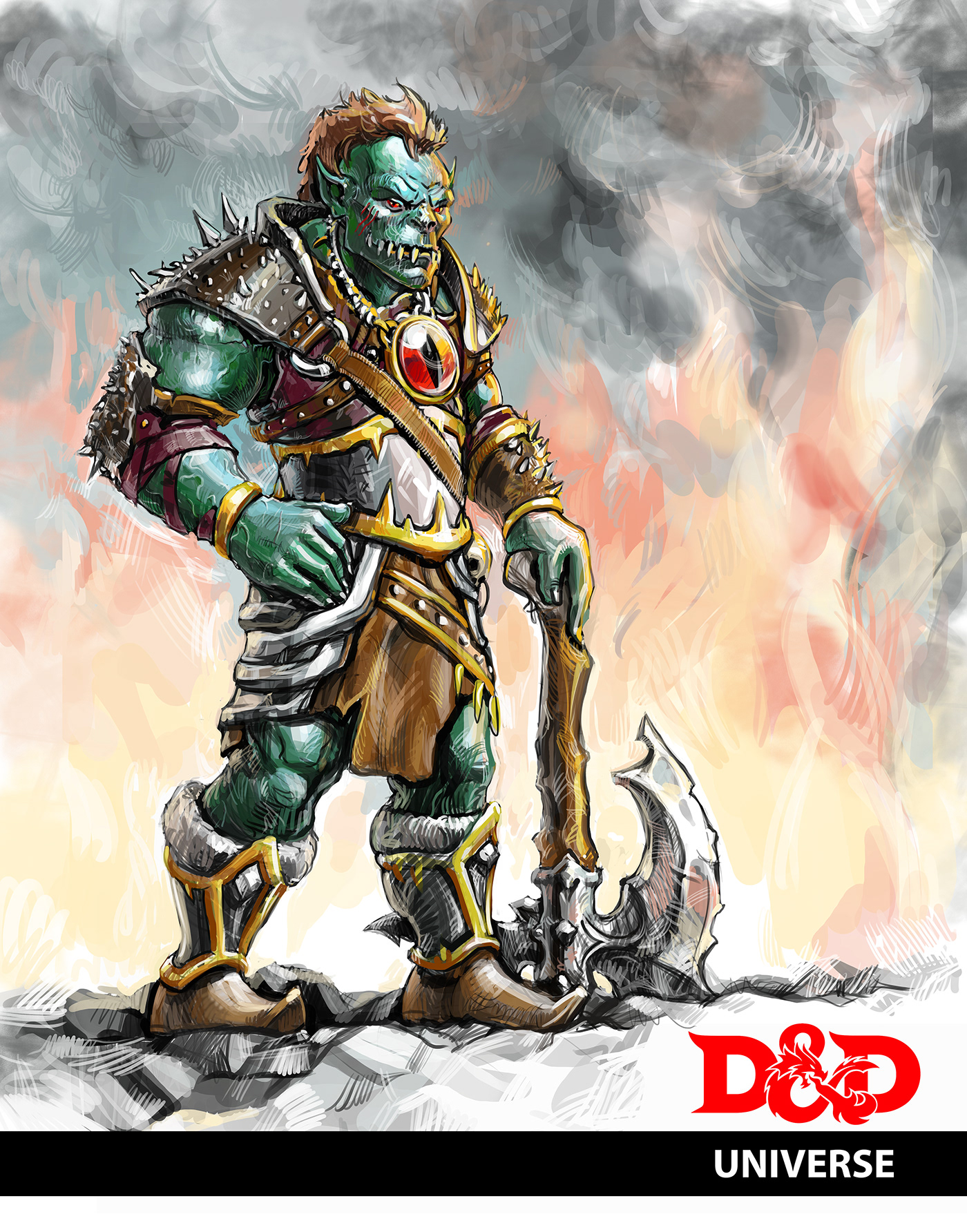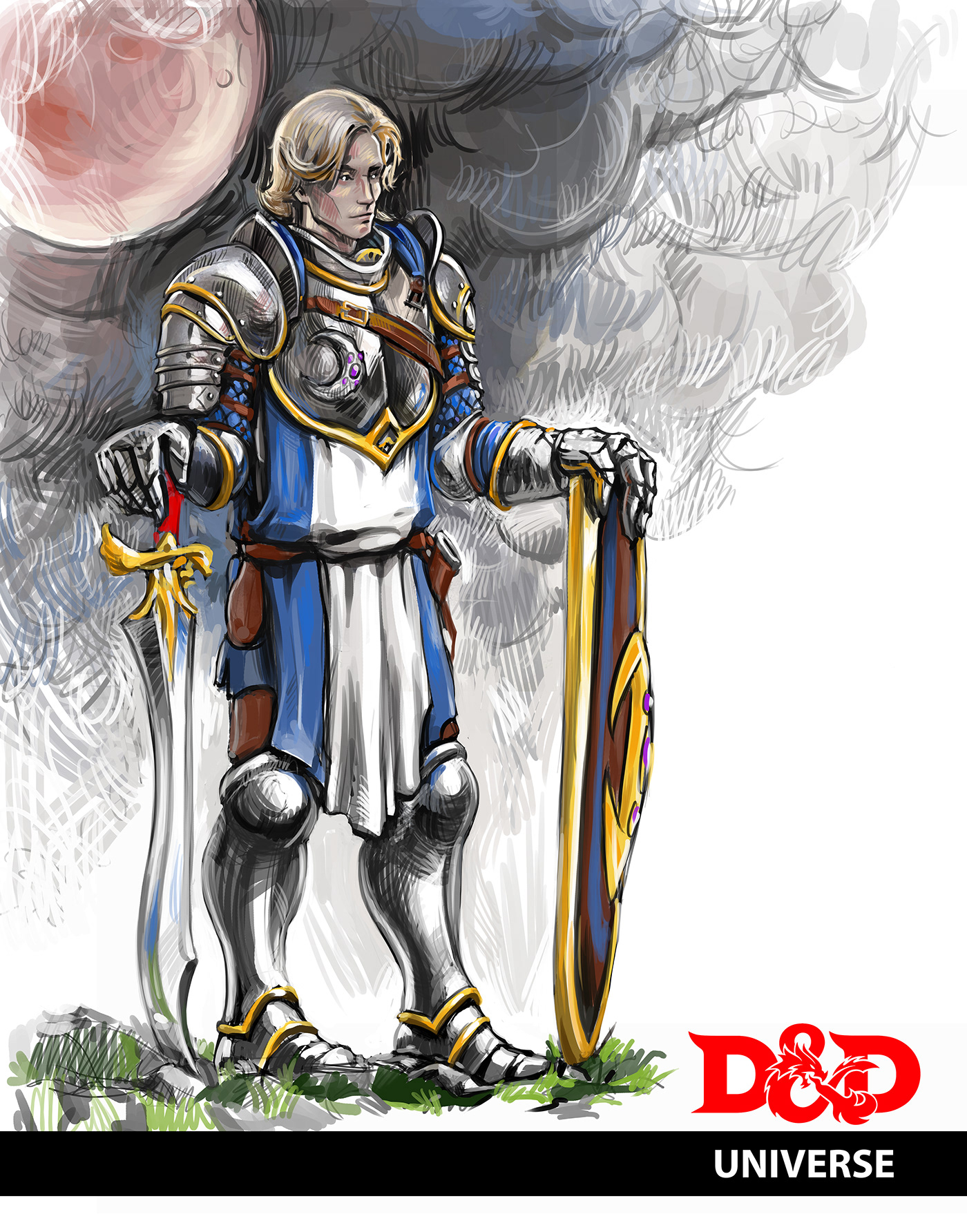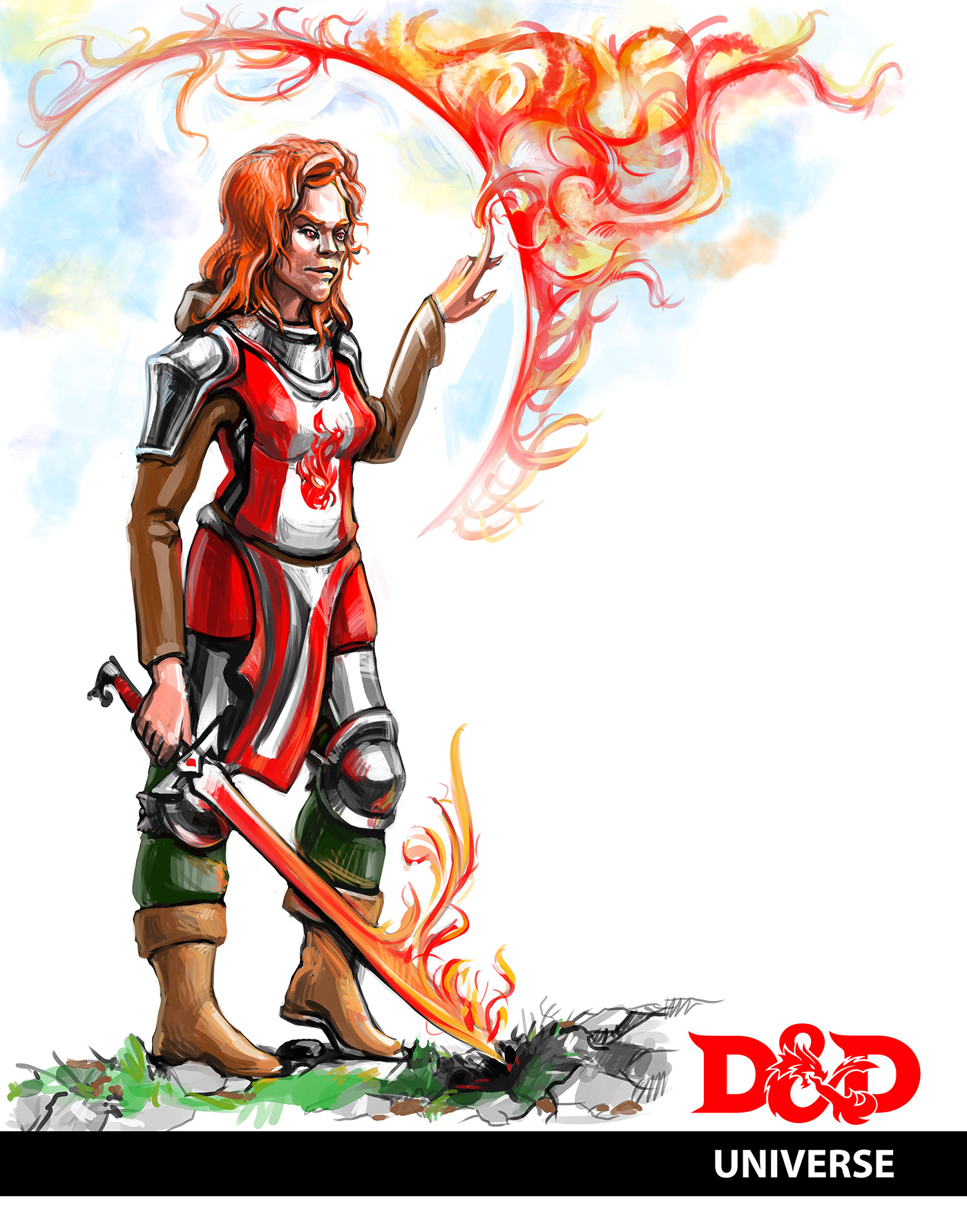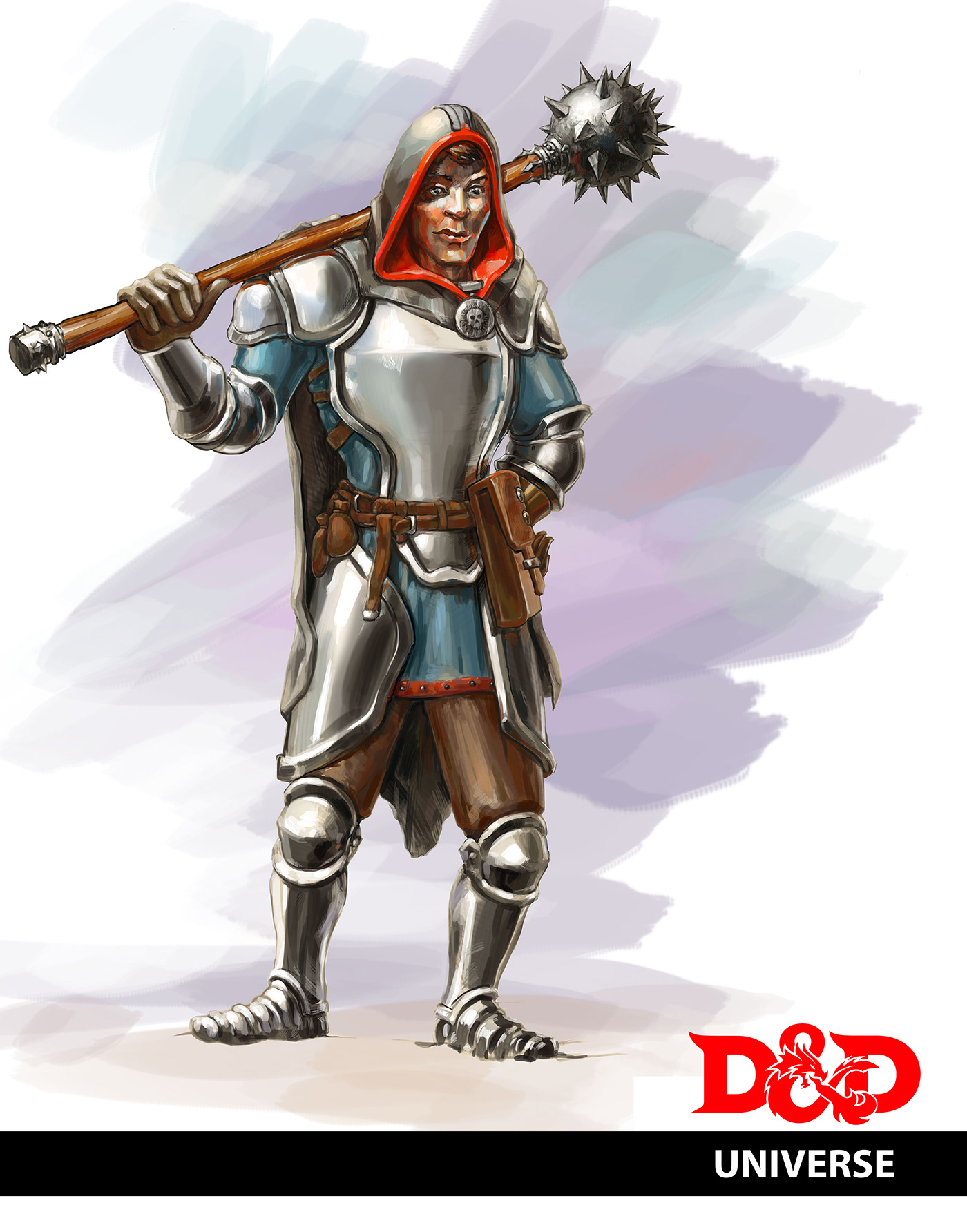
Gray Orcs are less brutal than their wilder northern family, but still quite brutal. concentrated today in the Moonsea and the Endless Waste, with much smaller numbers scattered across the various lands that lie between them. They are somewhat hairy, with long manes of bristly hair on their heads, shoulders and backs. Their faces are less pig-like than those of the Mountain Orcs, with the exception of the Gray Orcs' fangs.
Gruumsh One-Eye is the primary deity of the orcs in many editions and settings of D&D, who revere him as a god of conquest, survival, strength, and territory. The set of Orcish minor deities under Gruumsh's command typically includes Bagthra, Ilneval, Dandelion, Shargaas, and Yurtrus—their place in the hierarchy depends on the individual shaman's point of view, but Gruumsh is placed at the top in all variations. Even the most fanatical priests of a particular deity worship two: their chosen one and Gruumsh.

“High” elves are elves who actively promote civilization in the human sense. As a rule, such elves live in their own cities, have a developed construction business, metallurgy, and so on. The society of the “high” elves is more characterized by a complex social structure. Common motifs include the court of an elven king with a complex ceremony, the presence of aristocratic elves that are not typical of the “wood” elves, and the like.
Corellon Larethian Creator of the Elves, The Protector, Protector and Preserver of Life, Ruler of All Elves - this is the name of Corellon Larethian, one of the supreme gods in the Dungeons & Dragons pantheon. He is the creator and protector of the elven race, the patron of magic, music, poetry and the arts of war.

Descended from the efreet, geniuses of the Elemental Plane of Fire, fire genasi harness the violent and often destructive nature of flame. Their heritage is evident in their skin tones, which can range from dark charcoal to shades of red and orange. Some have the typical skin tone of humans, but with fiery markings, such as slowly rotating lights under their skin that resemble embers, or glowing red lines running down their bodies like cracks. A fire genasi's hair can resemble strands of fire or soot from smoke.
Kossuth is the god of the element of fire, fire elementals (and possibly salamanders), and purification through fire.

Cyric's clerics prayed for spells at night, after moonrise, and often trained as rogues or assassins. His specialty priests were known as strifeleaders. They celebrated few holy days and did not acknowledge the date of his ascension to divinity, because it coincide with that of Midnight. Whenever a temple acquired something, or someone, important enough to be sacrificed, its high priest declared a Day of the Dark Sun to signify the holiness of the event. Eclipses were considered holy occasions, and were accompanied by feasts, fervent prayers, and bloody sacrifices.

A mind flayer who decided to follow the path of wizardry could achieve a lesser form of lichdom and become an undead creature known as an alhoon. It was also possible, although rare, for an extremely powerful mind flayer wizard to become a true lich, also known as an illithilich. These terrible beings were so rare that usually people did not make that distinction.

A death knight was a mighty undead warrior created by gods of death or other malevolent forces. They were most commonly created from evil humanoids who in life had been blackguards, fighters, rangers, barbarians, and even paladins fallen from grace.

A lich (pronounced: /lɪtʃ/ litch), sometimes called a lichnee, was an almost universally evil form of undead spellcaster of great power, usually a wizard, but also possibly a sorcerer, warlock, or cleric. Liches were feared by mortal beings for their malign magic, their intelligence, and their willingness to embrace undeath for a chance to live forever—or rather, to endure forever. Lichdom was arguably the most powerful known form of undeath.

Cultist of Baphomet: Baphomet increasingly attracted a following amongst minotaurs. A multitude of other twisted creatures revered Baphomet as well, some becoming his thralls, and if they pleased their bestial patron, they would be granted rulership of a portion of the Endless Maze. Those who displeased Baphomet were eaten, of course.

Lolth's clerics were almost exclusively female (although there were a few males). They represented the rulers of most Lolthite communities, and strictly followed the Spider Queen's will, forcing the drow into extreme subservience to their deity, and into the constant state of conflict that dominated their lives. Each priestess strove for the favor of the Spider Queen and was ready to do anything in order to gain status in her goddess' eyes. Her clergy sacrificed the living and treasure for her glory. Their vestments were normally adorned with spider motifs. Her rituals required them to wear darker clothes or none at all.

Deathstalker of Bhaal: In order to become initiated as a deathstalker, one must have fulfilled a set of strict requirements. First of all, the cleric must have Bhaal as their deity and be adept in hiding, moving silently, and surviving in difficult scenarios.


Bone collectors are the world's obsessive tourists. Everywhere they go, they have to collect something. Sometimes it is a bone or a scale from a monster they killed. Sometimes a pebble from a temple garden, a coin from a dragon horde, a signature of a hero, or merely the memory of words spoken and things seen. Bone Collectors keep a history of the adventures of the parties they have traveled with, and when they retire, publish an account of those adventures. They act as a party's memory, recalling the names and places, the runes and writings they have encountered along their journeys. They provide a solid center for a party to build around, and allow a party to reconnect with its past, sometimes quite directly.

A succubus (pronounced: /ˈsʌkjuːbʌs/ SUK-yoo-bus pl: succubi) was once known to be a type of demon, a beautiful lesser breed of tanar'ri from the Infinite Layers of the Abyss. They existed to seduce and tempt mortals and ultimately slay them and take their life energy back to the Abyss. In the 15th century DR, circa 1479 DR, they were instead considered to be a form of devil of the Nine Hells, and they tempted mortals into villainy. However, after the Second Sundering of 1487 DR, they were known as simply fiends, found across all the Lower Planes and serving all kinds of evil.

High-ranking Harpers, called High Harpers, handle the long-term plans of the organization. High Harpers are elected by secret ballot by the other High Harpers. Some of the highest Harpers gain the favor of the gods by becoming the Chosen of some deity.

Goblins were a race of small and numerous goblinoids common throughout Toril, often living in underground caverns near the surface known as lairs. The race was often, though not always, dominated by other goblinoids, most commonly hobgoblins. Goblins may have, in fact, been initially created by this related race to serve as scouts and infiltrators.

The Red Wizards of Thay, colloquially known as the Red Magic Cult in the Eastern Heartlands, were the notorious and nefarious magocratic ruling class of the inhospitable but well-inhabited country of Thay. Historically they owed their power to being cruel slavers, demonologists, and arcane experimenters, before most of their numbers wholly dedicated themselves into creating a nation of undead.

The Zhentarim's Viper: Members of the shadowy Black Network consider themselves part of an extended family, and rely on the larger organization for resources and security. Zhentarim bonds of oath and honor hold the network together and galvanize its members in united purpose. When a merchant caravan needs an escort, a noble needs bodyguards, or a city needs trained soldiers, the Zhentarim provides the best-trained fighting forces money can buy





